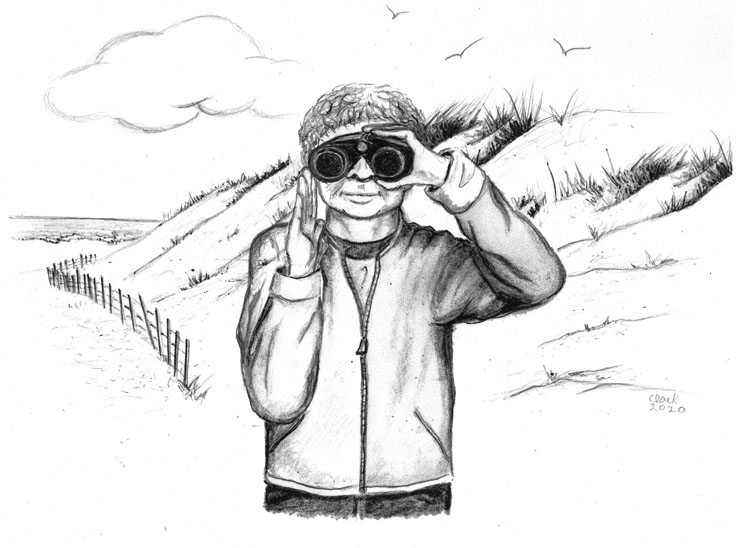
Advice for using new binoculars:
As a guy who has been using binoculars every day since the last Ice Age, I sometimes forget that the rest of society isn’t always as familiar with them. I’ve seen people look through the wrong end (really), or try to turn and twist parts that aren’t made to be turned or twisted. With that in mind, I’d like to pass on a little advice to those folks who may have gotten their very first pair of binoculars this Christmas. And for those people who already own binoculars, you might also want to read this. Maybe it will stop you from looking through the wrong end.
The first thing to keep in mind is that binoculars are somewhat fragile. Basically, they consist of critically aligned lenses and prisms. As a result, binos don’t like to be dropped. If they fall, they could lose this critical alignment and you will start seeing double images, like you do when you cross your eyes. But unlike your eyes, your binoculars really will “stay that way.”
New binoculars typically come with covers for both the eyepieces and the front lenses. Many newbies feel the need to use these covers. This is a personal choice, but it’s not one I subscribe to. Birds are active creatures and often only allow for a fleeting glimpse. They certainly aren’t going to wait around while I fumble with my lens covers. Besides, I’m only going to lose them anyhow. Some covers are tethered directly to the binoculars, which prevents them from getting lost. I don’t care. I’d find the dangling covers to be a distraction. Plus, as a birder, I already look nerdy enough without having weird things hanging off my equipment. Speaking of equipment…
For decades binocular manufacturers have totally ignored a huge percentage of the population – eyeglass wearers. People who wore eyeglasses felt they needed to remove them if they wanted to get the most out of their binoculars. Fortunately, those days are over. Most binoculars now come equipped with an adjustment for eyeglasses. This is how it works. With a simple twist, we can move the rubber cups (on the eyepieces) up or down. People without glasses should twist their cups up, while folks wearing glasses should twist their cups down. Why is this cup twisting important? Eyeglasses (not contact lenses) prevent binoculars from getting close to your eyes and thus, they narrow your field of view; twisting the cups down helps to eliminate this problem. Some stubborn people still remove their glasses while using binoculars, but this is a mistake. Keep your glasses on. Heck, you already have four eyes, having six isn’t going to hurt you.
With a few exceptions, all binoculars are hinged in the middle. This allows the two barrels to be spread in or out. Why spread the barrels? Some people have fat heads, while others are pinheads. Moving the barrels in and out enables you to adjust for the distance separating your two eyes. The goal is to see one clear circle, not two half circles, which would be the case if the barrels didn’t move. This brings me to a major gripe of mine. When moviemakers want to give us a “binocular view,” they show two circles side-by-side (?) like a sideways number eight or the symbol for infinity. Sorry, Hollywood, this is not what gazing through binoculars looks like. When you look through binos, you should see a single round circle. If you don’t, there is something wrong…or you’re looking through the wrong end.
One of the hardest things for beginners to do is to quickly locate a specific target. They see a bird with their naked eyes, but when they flip up their binoculars, they suddenly can’t find it. Early on this can be frustrating, but it’s just a matter of practice. In the meantime, here are a few tricks to help you out. When you see a bird, don’t take your eyes off it. With your eyes fixed on the target, slowly move your binos in front of your eyes. Your bird should now be in view. It also helps to remember detailed parts of, say, the tree your bird is in. It could be near the trunk, or a dead branch, or next to Charlie Brown’s entangled kite. Finding a larger nearby object will help you lock onto the bird. A lot of older people will use a number on a clock face as guidance. They’ll say, “The oriole is in the oak tree at three o’clock.” That’s great, except fewer and fewer younger folks understand analog clocks anymore. You’d be better off using a more current, hipper reference…like the one about Charlie Brown’s kite.
Finally, you’ll have to learn to hold your new binoculars as stable as possible. Binoculars make birds look larger, but if you aren’t rock steady, the birds will also be blurry. The traditional way to hold binoculars is with two hands, while your elbows are splayed out to the side, like you are doing The Chicken Dance. However, I find it better to keep my left hand in the customary position, while I use the fingers of my right hand to prop-up the binos from underneath. And instead of sticking my right elbow out like a chicken wing, I press it tight against my rib cage. Now my entire body is helping to keep the image steady. It looks a little goofy, but it’s still better than having lens covers dangling everywhere. Nobody needs that.
Above all, the most important thing to do with your new binoculars is to use them…a lot. The more often you take them out, the better you’ll be at using them, and eventually you’ll start seeing more birds…assuming you remember to look through the correct end.